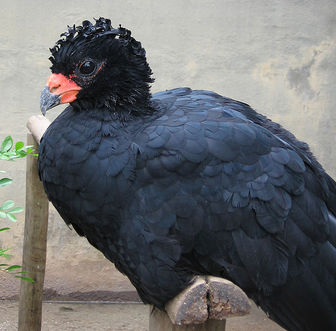Red-billed curassow
The Red-knobbed Curassow or Red-billed Curassow, Crax blumenbachii, is an endangered species of Cracid that is endemic to lowland Atlantic Forest in the states of Espírito Santo, Bahia and Minas Gerais in southeastern Brazil. Its population is decreasing As suggested by its common name, the male has a largely red bill, but this is lacking in the female.

The Red-billed curassow is classified as Endangered (EN), considered to be facing a very high risk of extinction in the wild.
The Red-knobbed Curassow or Red-billed Curassow, Crax blumenbachii, is an endangered species of Cracid that is endemic to lowland Atlantic Forest in the states of Espírito Santo, Bahia and Minas Gerais in southeastern Brazil. Its population is decreasing due to hunting and deforestation, and it has possibly been extirpated from Minas Gerais. It is currently being reintroduced to Rio de Janeiro by means of individuals bred in captivity. As suggested by its common name, the male has a largely red bill, but this is lacking in the female. More
The Endangered Red-billed Curassow Crax blumenbachii is endemic to the Brazilian Atlantic Forest, which once covered 1 million km2 of Brazil, but has been reduced to isolated fragments, mostly along the coast of Brazil. Because of its large size and attractive appearance, Red-billed Curassow is hunted for food and the bird trade. More
The Red-billed Curassow is a large bird belonging to the Cracidae family. This species of curassow has suffered heavily from hunting throughout the Neotropics and as they spend most of their time on the forest floor they are easy prey for other wildlife and are also particularly susceptible to habitat destruction. The total population in the wild is estimated to be as low as 250 individuals and consequently the Red-billed Curassow is critically threatened with extinction. More
The red-billed curassow spends most of its time on the ground where it forages for food, usually in pairs or small family groups of up to four birds (2). Foods taken include fallen fruits, tender leaves, seeds, buds and insects (2) (4). The main breeding season is from September to October, when the males’ booming calls can most often be heard, with chicks hatching over the next few months (4). More
The red-billed curassow has suffered from habitat loss and hunting, and is now thought to be on the brink of extinction, with fewer than 250 individuals estimated to remain in small, fragmented subpopulations. Virtually all lowland forest north of Rio de Janeiro has disappeared outside of reserves, having been converted to plantations and pastureland. Even in Monte Pascoal National Park, habitat loss continues as a result of conflicts over the land rights of local people. More
The Red-billed Curassow Reintroduction Project at REGUA = Habitat loss and hunting threaten the endemic Red-billed Curassow Crax blumenbachii (Galliforme, Cracidae) with extinction in the wild. Current estimates suggest that only 250 birds survive in six Brazilian Atlantic Forest remnants, in Bahia and Espírito Santo State. This endangered cracid was extinct in Rio de Janeiro State sometime during the 60's. More
Red-billed curassow: flagship for the Atlantic Forest = Field Conservation Latin America Trinidad Piping-guan Red-billed curassow White-winged guan Southern helmeted currassow Species List Africa South Central Asia Eastern Asia South East Asia The red-billed curassow inhabits only a handful of sites in the Brazilian Atlantic Forest. More
Conservation of the Red-billed Curassow at Reserva Ecologica de Guapiacu (REGUA), Brazil = Region: - The Reserva Ecologica de Guapiacu is situated in the Serra do Mar that runs along the south-eastern coast of Rio de Janeiro state, Brazil. More
that the red-billed curassow is now largely restricted to four or five reserves in Brazil, and that only two of these reserves hold populations of more than 50 birds? Factsheet Class AVES Order GALLIFORMES Suborder CRACI Family CRACIDAE Name (Scientific) Crax blumenbachii Name (English) Red-billed Curassow More
A Camera-Trapping Survey of the Endangered Red-Billed Curassow in Atlantic Rainforest, Brazil Descobrimento National Park. Red-billed curassow. More
Red-billed Curassow has been proposed, the Wattled Curassow seems to be a quite basal lineage without particularly close relatives. The similarity with the Red-billed Curassow seems to be mostly due to the fact that these are the most ancient species of their lineage, retaining more common plesiomorphies.(Pereira & Baker 2004) From captivity, hybrids with the quite distinct Blue-billed Curassow are known (del Hoyo 1994). More

